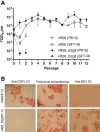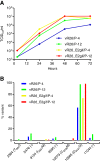Efficient generation of recombinant RNA viruses using targeted recombination-mediated mutagenesis of bacterial artificial chromosomes containing full-length cDNA
- PMID: 24262008
- PMCID: PMC3840674
- DOI: 10.1186/1471-2164-14-819
Efficient generation of recombinant RNA viruses using targeted recombination-mediated mutagenesis of bacterial artificial chromosomes containing full-length cDNA
Abstract
Background: Infectious cDNA clones are a prerequisite for directed genetic manipulation of RNA viruses. Here, a strategy to facilitate manipulation and rescue of classical swine fever viruses (CSFVs) from full-length cDNAs present within bacterial artificial chromosomes (BACs) is described. This strategy allows manipulation of viral cDNA by targeted recombination-mediated mutagenesis within bacteria.
Results: A new CSFV-BAC (pBeloR26) derived from the Riems vaccine strain has been constructed and subsequently modified in the E2 coding sequence, using the targeted recombination strategy to enable rescue of chimeric pestiviruses (vR26_E2gif and vR26_TAV) with potential as new marker vaccine candidates. Sequencing of the BACs revealed a high genetic stability during passages within bacteria. The complete genome sequences of rescued viruses, after extensive passages in mammalian cells showed that modifications in the E2 protein coding sequence were stably maintained. A single amino acid substitution (D3431G) in the RNA dependent RNA polymerase was observed in the rescued viruses vR26_E2gif and vR26, which was reversion to the parental Riems sequence.
Conclusions: These results show that targeted recombination-mediated mutagenesis provides a powerful tool for expediting the construction of novel RNA genomes and should be applicable to the manipulation of other RNA viruses.
Figures





References
-
- Almazan F, Dediego ML, Galan C, Escors D, Alvarez E, Ortego J, Sola I, Zuniga S, Alonso S, Moreno JL, Nogales A, Capiscol C, Enjuanes L. Construction of a severe acute respiratory syndrome coronavirus infectious cDNA clone and a replicon to study coronavirus RNA synthesis. J Virol. 2006;80(21):10900–10906. doi: 10.1128/JVI.00385-06. - DOI - PMC - PubMed
Publication types
MeSH terms
Substances
LinkOut - more resources
Full Text Sources
Other Literature Sources

